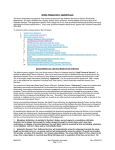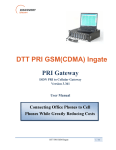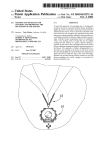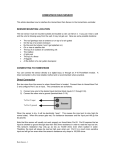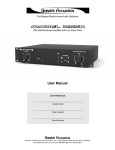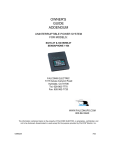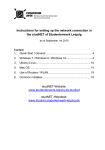Download Addendum-CottageSitt.. - Absolute Automation Knowledgebase
Transcript
SENSAPHONE ® Model 1104/08 CottageSitter Addendum Your local CottageSitter dealer: Sensaphone® Model 1104/1108 User’s Manual Model 1104/08 Owner’s Manual Addendum Sensaphone CottageSitter How to use this Addendum This is a supplement to the Sensaphone 1104/08 Owner’s Manual. Review the entire manual before reading this addendum. This addendum does not explain the Sensaphone setup, configuration, or operation. The purpose of this addendum is to instruct you on how to use the remote control functions of your Sensaphone to turn on or turn off devices such as a furnace thermostat, air conditioner, or lights in your cottage or cabin. Sensaphone 1104/08 CottageSitter Feature The Sensaphone 1104/08 CottageSitter allows you to monitor and check on the status of your cottage or cabin from any cellular or ordinary telephone. The Sensaphone 1104/08 CottageSitter also allows you to turn a device on or off using the 1104/08 keypad or using your touch-tone telephone. You can also inquire about the status of the device during a voice status report. This Sensaphone contains a relay contact on the rear of the unit (see Figure 1). The relay contact supports both a normally open and a normally closed contact, commonly referred to as a “double throw” relay. When the Sensaphone relay is turned ON, a connection is made between the ON and C (common) terminals and the connection to the OFF terminal is disconnected. When the Sensaphone relay is turned OFF, a connection is made between the OFF and the C (common) terminals and the connection between the ON and C (common) is disconnected (See Figure 1). When the Sensaphone unit is put in standby mode, the relay remains in its last known state. If the Sensaphone is completely shut down by removing the batteries and unplugging it from power, the relay returns to an OFF state, connecting the OFF terminal to the C (common). The Sensaphone relay is a low voltage relay. Only voltages less than 30 volts AC 2AMPS, or 30 volts DC 2 AMPS may be switched. For higher voltages, an additional high-voltage relay would be required. Always enlist the services of a licensed electrician when working with high voltages. Improper wiring can cause harm to you or your property. A-1 CottageSitter Addendum NOTE: For safety reasons it is highly recommended that the unit only be used to switch low voltage signals (30 volts or less). If you intend to control higher voltages you must install the unit in an NEC approved electrical panel or enclosure and have wiring performed by a qualified electrician. Switching the Output using the Keypad To switch the output ON from the keypad: 1. Press STATUS. STATUS CONFIGURE 2. Press 6. 6 CALIBRATE To switch the output OFF from the keypad: 1. Press STATUS. STATUS CONFIGURE 2. Press 3. 3 INTERCALL TIME Switching the Output over the Telephone 1. Call the Sensaphone. When the unit answers it will begin reciting a status report. At any time during the call, press a touch-tone. The unit will respond with “OK.” The Sensaphone is now ready to accept touch-tone commands. 2. On your phone, press # 6 to turn ON the output. The Sensaphone will respond “ON.” + A-2 Sensaphone® Model 1104/1108 User’s Manual 3. Press pound # 3 to turn OFF the output. The Sensaphone will respond “OFF.” + 4. To check the present state of the relay press # 2. + This initiates a full recitation of the Status Report. At the end of the status report, the Sensaphone will say “Number five On/Off” for the Model 1104 CottageSitter, and “Number nine On/Off” for the Model 1108 CottageSitter. Heating up your Cottage or Cabin Remotely If you keep your cottage or cabin open all year around, or if you do not drain your pipes and antifreeze your plumbing, you likely keep your furnace active when you are away but at a very low temperature. The Sensaphone will provide an invaluable service to you by keeping you updated to any change in the status of your furnace operation. Prior to your arrival at your cottage or cabin, you can remotely use your phone to instruct the furnace to increase the heat. Most furnaces use a typical 4-wire (heat/cooling) or 3-wire (heat only) thermostat. The Sensaphone can easily control these types of thermostats. If your heating source consists of high voltage electric baseboard heaters, you should consult a qualified electrician or heating professional for proper installation of the Sensaphone remote control facility. Electric baseboard heaters may utilize either a low voltage (2-wire) thermostat or a direct control high voltage thermostat. Only the low voltage thermostat may be directly connected to the Sensaphone. There are two methods to control your furnace remotely: 1) The Dual Thermostat Concept or 2) The Sensaphone Setback Thermostat. The Dual Thermostat Concept When a three or four wire low voltage thermostat is used, it is easy to connect the Sensaphone to your furnace with the addition of a secondary thermostat. One thermostat is set to your preferred A-3 CottageSitter Addendum “away” temperature and the other thermostat is set to your preferred “home” temperature. With your Sensaphone CottageSitter, you will be able to switch between these two thermostats. Ideally, the “away” thermostat would be in your pump or furnace room. Remember that your “away” thermostat will be the only thermostat that keeps your cottage or cabin at minimal heat while you are away. It should not be located near a window or where direct sunlight might warm it, near a furnace radiator or vent, or any heat source such as a pilot light. The second thermostat, the one pre-set for your preferred temperature when you arrive at your cottage or cabin, should be located in your normal living space. This would likely be your existing thermostat, already located in a suitable location by your heating professional at the time your furnace was installed. By connecting these two thermostats together in a parallel fashion, and by passing the low voltage supply through the Sensaphone (See Figure 1), you can remotely or locally decide which thermostat is in control of your furnace. It is recommended that the “away” thermostat be connected to the OFF terminal while the “home” thermostat be connected to the ON terminal of the Sensaphone. This way, it’s easy to understand which state your furnace is in: ON = Home and OFF = Away. The supply voltage from your furnace (typically the wire labeled R or 24VAC), should always be connected to the C (Common) terminal on the CottageSitter. Figure 1: Dual Thermostat Setup A-4 Sensaphone® Model 1104/1108 User’s Manual The Sensaphone Setback Thermostat By replacing your existing thermostat with the Sensaphone Setback Thermostat (sold separately), the control of your furnace is done through one thermostat that is pre-programmed with an “away” and a “home” temperature setting. The Sensaphone Setback Thermostat has an LCD readout that lets you enter the desired setpoint for both your “away” and “home” temperatures. A control signal is sent from your Sensaphone to switch between these two settings (See Figure 2). The advantage of this configuration is the use of only one thermostat for all heating and air conditioning tasks. A simple pair of wires connects this thermostat to your Sensaphone. The thermostat is compatible with existing 4-wire and 5-wire thermostats, so installation is fast and easy. It is important to understand that if you use the Sensaphone Setback Thermostat, location is important. If you leave the furnace radiators or vents in your main living area closed off when you are not there and the door to your furnace or pump room is closed off, the thermostat will not be obtaining an accurate reading of the temperature in that furnace room, thus producing unpredictable heating results. Figure 2: Sensaphone Setback Thermostat Setup A-5 CottageSitter Addendum Controlling Lights or other devices with Sensaphone Using X10 technology, you can remotely activate any electrical device or appliance in your home through your Sensaphone. X10 technology is a suite of control modules that plug into your existing electrical outlets and transmit coded signals to lamps, lights, and appliances to turn them on or off (See Figure 3). ON GND Lamp/Light Module 1 GND 2 GND 3 GND C OFF 4 Powerflash Module Figure 3: X10 Lighting Control Setup Sensaphone supports these devices through use of the popular X10 Powerflash relay interface. To learn more about this technology, consult X10 products on the web at www.x10.com or visit your local electronics shop such as Radio Shack. Such applications may include turning on a lamp or exterior lights remotely from your cellular telephone when arriving at your cottage or cabin late at night. Or you can use the X10 Powerflash Module (set to momentary contact) in conjunction with the X10 Universal Module to remotely control your electric garage door opener over the telephone—an ideal way of letting in your cottage or cabin service personnel without being on-site. You may also use the X10 technology to send the ON/OFF signal to a furnace or heater if your thermostat is not easy to wire directly. Finally, in addition to remotely controlling devices, X10 technology lets you extend the reach of certain Sensaphone sensors such as door contacts, motion sensors, or water sensors. This of great benefit where it is impossible to wire directly from your sensors to your Sensaphone. Consult a qualified electrician or your heating professional for assistance with locating your remote sensors or contact your Sensaphone dealer. A-6 Relay Output Specifications Rated Load: 2 A at 30 VAC 2 A at 30 VDC Max. Operating Voltage: 30 VAC 30 VDC Max. Operating Current: 2A Max. Switching Capacity: 60 VA 60 W Every effort has been made to ensure that the information in this document is complete, accurate and up-to-date. SENSAPHONE, INC. assumes no responsibility for the results of errors beyond its control. SENSAPHONE, INC. also cannot guarantee that changes in equipment made by other manufacturers, referred to in this addendum, will not affect the applicability of the information herein. Addendum © 2002 by Phonetics, Inc.










